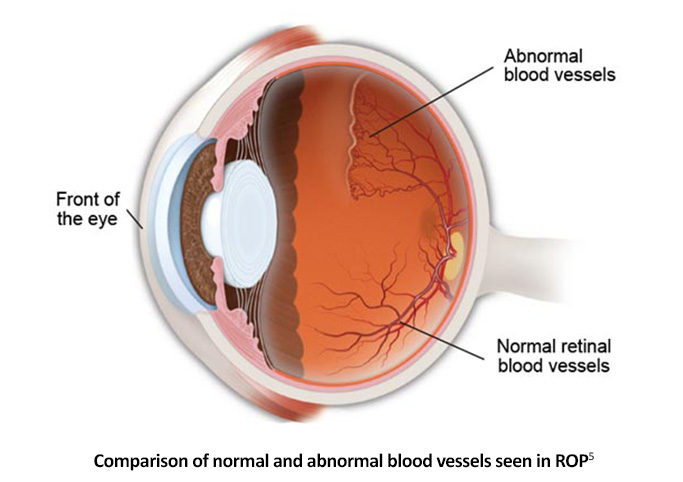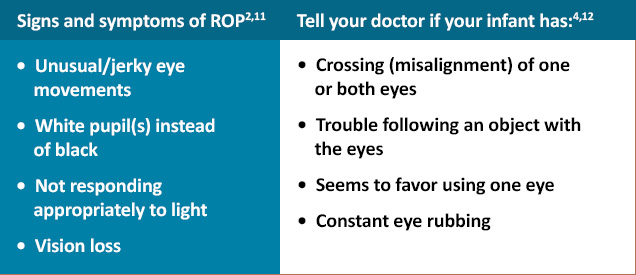What is Retinopathy of Prematurity (ROP)?
Retinopathy of Prematurity (ROP) is an eye disorder caused by the growth of abnormal blood vessels (called neovascularization) throughout the retina, a layer of tissue lining the back of the eye that senses light.1,2 Infants born preterm are at the highest risk for ROP because their retinal blood vessels have not fully developed to the edge of the retina.2 After birth, the edge of retina is still underdeveloped and sends signals for oxygen and nutrients.2,3 This causes abnormal blood vessels to begin growing.2 Since the structure of these abnormal blood vessels is fragile, they can leak blood into the retina and cause scarring.2,4 As the scar tissue shrinks, it can pull on the retina tissue, causing it to detach from the back of the eye.2

Infants at risk for ROP receive retinal examinations at carefully timed intervals to monitor blood vessel growth and determine whether treatment is necessary.6 Infants with low birth weight (weight less than 1500 grams/3 pounds) or gestational age of 30 weeks or less (with 38-42 weeks considered full-term) will be screened for ROP.1,2,7
A small percentage of infants who are not preterm or exhibit low birth weight may still be at risk for ROP, related to a failure to gain weight after birth or other health issues.8 Of all infants at risk for developing ROP, approximately 50% will develop ROP and 7% will need treatment.9,10 In milder cases, ROP often resolves without treatment, leaving behind no permanent damage. However, in more severe cases, ROP can impair vision or even result in blindness.1

Most infants with ROP have normal vision for their age.9,10 Signs and symptoms of ROP are present in more advanced stages and infants will be checked thoroughly at each exam.1,4,11 Any observed changes in eye alignment or certain infant behaviors could be a potential indicator of reduced vision and should be promptly reported.4,12

References
- Fierson WM, American Academy of Pediatrics Section on Ophthalmology; American Academy of Ophthalmology; American Association for Pediatric Ophthalmology and Strabismus; American Association of Certified Orthoptists. Screening Examination of Premature Infants for Retinopathy of Prematurity. Pediatrics. 2018;142(6):e20183061.
- National Eye Institute. Retinopathy of Prematurity. Last updated June 24, 2022. https://www.nei.nih.gov/learn-about-eye-health/eye-conditions-and-diseases/retinopathy-prematurity
- Yokenawa Y, Chan RVP. Retinopathy of Prematurity. EntoKey. 2020. https://entokey.com/12-retinopathy-of-prematurity/
- NORD Rare Disease Database. Retinopathy of Prematurity. https://rarediseases.org/rare-diseases/retinopathy-of-prematurity/
- South Bay Ophthalmology. Retinopathy of Prematurity. https://www.southbayophthalmology.com/patient-education/retinopathy-of-prematurity/
- Early Treatment for Retinopathy of Prematurity Cooperative Group. Revised indications for the treatment of retinopathy of prematurity: results of the Early Treatment for Retinopathy of Prematurity randomized trial. Arch Ophthalmol. 2003;121(12):1684-1694.
- MedlinePlus. Gestational age. https://medlineplus.gov/ency/article/002367.htm
- Binenbaum G, Tomlinson LA, Campomanes AG. Validation of the Postnatal Growth and Retinopathy of Prematurity Screening Criteria. JAMA Ophthalmol. 2020;138(1):31-37.
- Quinn GE, Ying GS, Bell EF, et al. Incidence and early course of retinopathy of prematurity: Secondary analysis of the Postnatal Growth and Retinopathy of Prematurity (G-ROP) study. JAMA Ophthalmol. 2018;136(12):1383-1389.
- Binenbaum G, Tomlinson LA. Postnatal Growth and Retinopathy of Prematurity Study: Rationale, design, and subject characteristics. Ophthalmic Epidemiol. 2017;24(1):36-47.
- American Society of Retina Specialists. Retinopathy of Prematurity. https://www.asrs.org/patients/retinal-diseases/17/retinopathy-of-prematurity
- Preemie Heroes. Retinopathy of Prematurity (ROP). https://www.preemieheroes.com/blog/preemies/preemie-info/retinopathy-of-prematurity-rop/
- Tamura MYY, Teixeira LF. Leukocoria and the red reflex test. Einstein. 2009. 7(3 Pt1):376-382.
URLs accessed 7/6/22.










